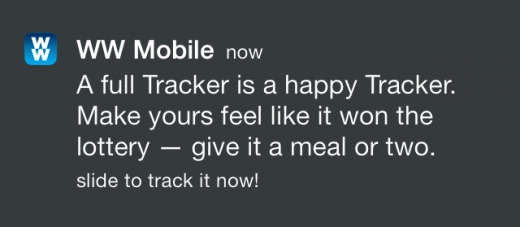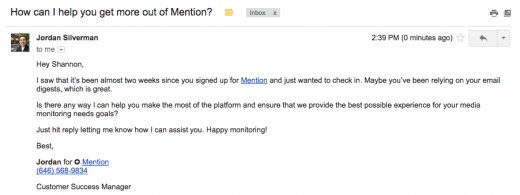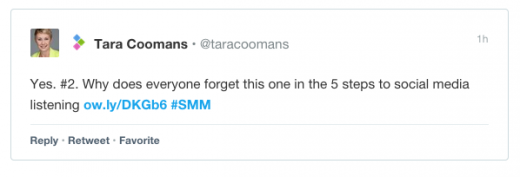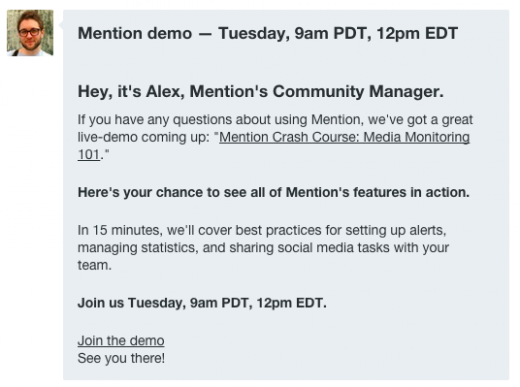
Shannon is the Chief Content Officer for CloudPeeps, where she crafts words, creates strategies, and recruits loyal brand advocates. She’s also the founder of asongaday.co, hand-curated songs delivered to your inbox, and an enthusiast of live music, sunshine, craft beer, and quality content. She’s in Brooklyn, NY. Say hi @ShannnonB. This post originally appeared on the Mention blog.
Ah, that moment when you’re finally seeing traction with your content and community efforts. Visits have spiked because you’ve found that sweet spot for distribution. People are sharing and commenting because you’ve found the value-add your audience was looking for. People are even clicking through and signing up because you nailed down your call-to-actions. Customer engagement is at an all-time high.
Feels good, doesn’t it?
But then something terrifying happens. Traffic starts to slow, comments taper off, social shares become few and far between, and product use starts to slow. Yikes.
It’s possible that you didn’t put preventative measures into place, such as building an email list from the beginning, or laying the foundation for a solid SEO strategy. Or maybe you were focused on quick wins rather than long-term sustainable content strategies. That’s ok, it’s all about executing a mix of both.
Not to fret, there’s ways to win them back. Here’s five of them.
1. Get creative with your automated marketing messages
Automated marketing platforms (like Customer.io, Marketo, and Intercom) allow you to identify and segment customers based on their behaviors. Create a segment of customers who haven’t logged on or visited your site in a while. Although “a while” is subjective, I suggest targeting people who haven’t engaged with your brand in a month or longer. Anything less than a month could mean that they’ve been on vacation or had a very busy few weeks.
After identifying your segment, design an in-app or email message that will grab their attention and inform them on what they’ve been missing.
I really like Weight Watcher’s casual approach to push messages.
At Mention, we send gentle reminders via email.
2. Try new distribution channels
It’s a great feeling when you’ve found the mix of distribution channels that is effective for delivering your content to who needs it. However, you shouldn’t limit yourself. Always be looking for new opportunities for getting the word out.
You may have successfully built a loyal audience on the networks you’ve been using, but you never know when owners are going to pull the plug, or someone else ruins it for everyone by spamming and driving community members away.
Discover new networks with a media monitoring tool. Monitor keywords that are relevant to your brand to identify where people are having conversations around these terms. You may find new forums, social networks, specific hashtags, or even comments on blogs you should have a presence on
We discovered that people were discussing social listening within a #SMM (social media marketing) chat
Pro-tip: Use ubersuggest.org or Google’s Keyword Planner to identify additional keywords that people are using in conjunction with those you’ve already identified.
3. Detect behavioral & communication patterns with media monitoring
Use a media monitoring tool (like Mention or Moz’s Fresh Web Explorer) to track your own brand name and any variation of it, as well as your competition’s. These tools allow you to discover your broader audience by tracking any mention of you beyond those with your @handle or speaking directly to you, across different channels.
Use this intelligence to determine what people are saying about you online. Maybe people had a bad experience that you’re unaware of, there’s a bug you didn’t know about, or there’s a competitor on the rise that has everyone’s attention.
After identifying the issue at hand, reach out to these people to correct it, then release a public statement if the issue warrants it. Consider offering a discount or free month to any customers that have been inconvenienced.
For those who didn’t have an issue, but stopped talking about you, reach out and ask them what happened and what you can do to bring them back in a friendly manner. Consider doing this from a personal account, rather than a brand one so they know they’re talking to a human, and will therefore be more likely to respond.
4. Host an online or IRL event
It’s possible that your audience is slipping away because they simply forgot how awesome you are. Host an event online or even in real life to better get to know your audience and their needs and interests.
If hosting an online event, you have two broad choices in terms of focus:
- Educate your audience on your product or offering. If your product has a lot of features, your audience may have disappeared because they were overwhelmed. Reach out offering them a group demo that simplifies your product. Be sure to keep the demo simple, clear, and to the point, and to communicate how long the event will take in your message.
-
Educate your audience on a relevant topic. If it’s content you want to drive your audience to, more than your product or service, try hosting a Twitter chat, webinar, or AMA (ask me anything). Ask expert guests to join to discuss a topic of interest to your audience. Check out Buffer’s guide to hosting or joining a Twitter chat.
Pro tip: If you don’t want to host an AMA on reddit, but are interested in the concept, I’ve seen them done well within Facebook Groups, and on Inbound.org.
There’s really no alternative to the value of meeting your community in real life. It’s a chance to humanize your brand and receive honest, candid feedback, as well as to get to know your community on a personal level. Events don’t have to be big or expensive either.
I really like what Workable is doing with the #TalentHackers events in London and New York. They invite panelists to do a Q&A on a given hot topic in recruitment with time for networking. They make their presence known, but do not promote their product once. It’s an effective way to bring people together and show that you care about them.
5. Surprise & delight
Do you have high-value customers or audience members that are slipping away who could be your potential brand ambassadors? Go the extra mile and surprise and delight them with a gift. This could be sending them swag such as a t-shirt and stickers via snail mail or a free month of your service via email.
General Electric is the master of S&Ds. They are constantly going above and beyond to engage their audience in competitions and made up “holidays” like 3D Printing Day. These are huge productions that require a ton of resources, but the concept can be replicated on a smaller scale.
Setting yourself up for success
It’s good to know how to win your audience back, because you never know when something out of your control will happen. However, you should also be taking pro-active measures to prevent them from slipping away in any event. Make sure to have an effective and helpful onboarding process in place and to make your value clear in your messaging. These two small steps will go a long way.
Over to you. How do you engage and re-engage your audience?
Read Next: The 29 rules of social media, and which ones to break
Get the TNW newsletter
Get the most important tech news in your inbox each week.








